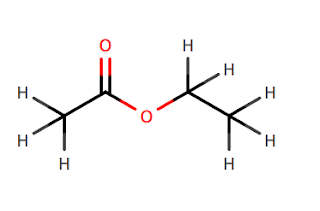Esters
are amazing molecules because you find them in all sorts of applications very
often where you would least expect them to be.
On
this chart there is the skeletal formulae, the name and the source of all the
esters mentioned.
Having
the name and skeletal formula allows you to match the name to each part of the
ester.
So
for example:
So
as you can see esters are ubiquitous: they are found in all sorts of places.
And
here is another fascinating fact about esters they are in space in a giant dust
cloud in the constellation Sagittarius on
which see here
So
let’s look at the properties of esters.
The
German chemist Leopold Gmelin was the first to give the name Ester to molecules with the –COO
functional group.
Here
is a typical ester display formula: ethyl
You
can see the key structure is the carbonyl group attached to a single oxygen
atom i.e. the –COO group.
Solubility in water
As
you might have already guessed the larger the alkyl groups on esters the less
likely they are to be water-soluble.
Large
esters especially fats and oils are insoluble in water.
You
will see that they do possess the –COO functional groups that can form strong
hydrogen bonds with water like this:
But
the energy released when esters form these bonds is less and less able to break
the van der Waals forces between the alkyl groups as these groups increase in
size.
Small
esters like ethyl methanoate and ethyl ethanoate are sparingly soluble in water.
Structure
Their
names are based on the carboxylic acid from which they are derived.
We
also remember that the name is the reverse of the way we write the structural
formula:
Ethyl ethanoate
CH3COOCH2CH3
The
colour coding above matches the parts of the formula of the ester to its name
so you can see how the name is the reverse of the formula.
The
above was an example but it is always best to test yourself to see if you can
work out the name from the formula and the formula from the name.
So
here are two lists in which you need to work out the name from the formula and
the formula from the name.
Formulae: what are
the names of these esters?
CH3COOCH3
CH3CH2CH2COOCH2CH3
HCOOCH2CH2CH2CH3
Names: what are the
formulae of these esters?
Methyl
propanoate
Hexyl
septanoate
Phenyl
butanoate
Synthesis
Esters
are best synthesised from the corresponding acid chloride and alcohol.
Here
is an example of this nucleophilic addition elimination reaction:
An
alternative reaction is to use the alcohol and carboxylic acid but this is a
slower reaction with a lower yield because the reaction is in equilibrium and
does not go to completion.
Big esters
Esters
can form polymers and lipids.
So
for example glycerol and fatty acids produce lipid molecules in a reaction like
this below:
This
is tristearin, a form of lipid that is a triglyceride:
The
fat will have a glycerol head and fatty acid tail.
These
lipid molecules can be saturated or unsaturated:
Saturated:
Unsaturated:
The
unsaturated fats can have cis and trans geometric isomers
Cis
and trans fats:
Trans
fats are quite toxic and difficult to breakdown in the digestive system.
Some
places and states in the US ban the use of trans fats in baking and other
products.
Polymeric esters
Terylene
is the original ICI trade name for the fibre spun from this polyester:
Biodegradable
esters: biopol
Bipol
is the biodegradable polymer polyhydroxybutyrate.
This
is its structure:
It
is environmentally friendly green polymer because is degrades relatively
quickly in landfill sites.
It
is produced from the fermentation of plant sugars and glucose usually derived
from starch type plants such as sweet potato.
It
has become a substitute plastic for plastic bags.
Such
bags degrade if left for a few weeks become weak and unusable.





















No comments:
Post a Comment